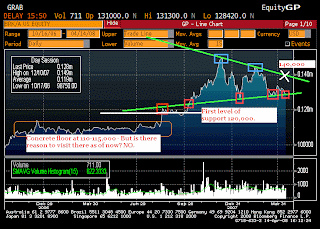I was very disturbed to read this, and read it several times today I did, and found myself restless into the end of my work day.
So I want to write it out and perhaps I learn something.
The complete article is at the bottom of this post, but here's what's so scary about the news:
The new price for China is $576 a ton, which was raised by $400 a metric ton (it was $176). A threefold increase.Okay, why are the Chinese so desperate?
China is among countries that are becoming more reliant on fertilizers to boost crop yields as the availability of arable land shrinks and populations grow.What about future potash purchases, will they still be on the short end of the stick?
``China will be kept on a short leash by producers that are keen not to allow for a possible restocking,'' Stiskin said. ``This shows that even China as the biggest net importer has had zero negotiation power'' with potash producers, Deutsche Bank AG said in a note to clients today.Okay, this is the "mark-to-market" on potash, which will be the new market price for everyone, including food exporter (like USA), whose demand on potash wouldn't cause such an immediate term shortage the way China and India did.
But the US is going to pay that same price for potash. And does this mean food prices will triple very shortly from here on?
Maybe not. It may
Quintuple instead.
The supply shortage may help the soil nutrient reach $1,000 a ton ``rather fast,'' Oleg Petrov, Uralkali's head of sales, said April 14.Is that
NOT a recipe for disaster, no pun intended? What - civil war in China I
MPOSSIBLE? What about $1,000 a week grocery bill for family of four in the US - that is
absurd, right?
The truth of the matter is, there is far more concern on my part about the continuity of economy or society in general than trading stocks related to the Ag-spec.
You've seen how otherwise non-supply constrained country faces an artificial constraint because a famine is unfolding in China.
The Chinese were dumb enough to slave for twenty years, destroy their ecosystems, in return for a bunch of worthless paper IOUs from some irresponsible spending-addicted nation.
But what about us? Keep doing nothing about this and as usual, by the time the riots broke, again what did they say? Close the barn door after what?
Hope you enjoy your dinner. I sure will mine.
The complete news:
==============
Potash Producers Raise Chinese Prices to a Record (Update3)
By Yuriy Humber
April 16 (Bloomberg) --
Potash Corp. of Saskatchewan Inc., the world's largest maker of the crop nutrient, and Russia's
OAO Uralkali raised prices for Chinese deliveries by $400 a metric ton to a record amid booming food demand.
Canadian trading company Canpotex Ltd., which markets potash on behalf of North American producers, agreed to the price increase with Chinese customers, Saskatoon, Saskatchewan-based Potash Corp. said today in a statement. Uralkali also said today in a statement it agreed to the gain.
China is among countries that are becoming more reliant on fertilizers to boost crop yields as the availability of arable land shrinks and populations grow. Global fertilizer demand is rising 5 percent a year, and there's a 1.2 million-ton potash production shortfall, Uralkali said last week. Potash, a form of potassium, protects crops from dryness and disease.
``This shows that even China as the biggest net importer has had zero negotiation power'' with potash producers, Deutsche Bank AG said in a note to clients today.
Uralkali depositary receipts
rose 3.85 euros, or 7.6 percent, to close at 54.80 euros on the London Stock Exchange. Potash Corp. rose C$10.35, or 5.5 percent, to C$198.50 at 4:15 p.m. in Toronto trading. Other potash producers also climbed: K+S AG, Europe's largest potash producer,
gained 3.6 percent in Frankfurt trading; Agrium Inc.
rose 7.7 percent in New York.
Belarus Output
Canpotex Ltd., which represents Agrium and U.S. producer Mosaic Co. and Potash Corp., will supply Chinese importer Sinofert Holdings Ltd. with 1 million tons at the new price this year.
Belarusian Potash Co., which trades the mineral for Uralkali and Minsk-based producer Belaruskali, said today in an e-mailed statement it agreed the same price change and volume. It supplied 2.2 million tons to China in the first half of last year by Rail, Belarusian Potash said on its Web site.
The 2 million tons Canpotex and Belarusian Potash committed to China for the second half of this year is a significant reduction on last year's level,
Mikhail Stiskin, an analyst with Troika Dialog in Moscow, said in a research note.
``China will be kept on a short leash by producers that are keen not to allow for a possible restocking,'' Stiskin said.
Exports to China by Canpotex and Belarusian Potash will resume in June after a three-month stoppage due to price negotiations. India signed a contract with the two trading companies, which market more than half the world's potash, last month at a record $625 a ton, including freight costs.
Freight Costs
The new price for China is $576 a ton, excluding freight costs, Plymouth, Minnesota-based Mosaic said today in a statement. The price will be $665, including delivery costs, according to JPMorgan Chase & Co. analysts including
Jeffrey J. Zekauskas. Troika Dialog estimates $670.
The supply shortage may help the soil nutrient reach $1,000 a ton ``rather fast,''
Oleg Petrov, Uralkali's head of sales, said April 14. Petrov said spot prices in other markets including Latin America will follow the Chinese benchmark and approach $750, including freight costs, by June.



























 US Consumer Sentiment Index 1989 - 2008.
US Consumer Sentiment Index 1989 - 2008.